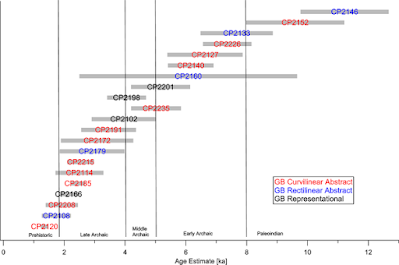Map Rock Site, Snake River valley, Idaho.
"Rock art originated some 46,000 years ago and can provide unique insights into the minds of our human ancestors. However, dating of these ancient images, especially of petroglyphs, remains a challenge. In this study, we explore the potential of deriving age estimates from measurements of the areal densities of manganese (Dmn) and iron (Dfe) in the rock varnish on pertoglyphs, based on the concept that the amount of varnish that has regrown on a petroglyph since its creation, relative to the surrounding intact varnish, is a measure of its age. We measured (Dmn) and (Dfe) by portable X-ray fluoresence (pXRF) on dated Late Pleistocene and Holocene rock surfaces, from which we derived accumulation rate of Mn and Fe in the rock varnish. The observed rates were comparable to our previous findings on basalt surfaces in North America. We derived age estimates for the rock art at four sites in the northern Great Basin region of North America based on Dmn measurements on the petroglyphs and intact varnish. They suggest that rock art creation in this region began around the Pleistocene/Holocene transition and continued into the Historic Period, encomassing a wide range of styles and motifs. Evidence of reworking of the rock art at various times by indigenous people speaks of the continued agency of these images through the millennia. Our results are in good agreement with chronologies based on archeological and other archaeometric techniques. While our method remains subject to significant uncertainty with regard to the absolute age of individual images, it provides the unique opportunity to obtain age estimates for large ensembles of images without the need for destructive sampling." (Andreae and Andreae 2022)
Celebration Park site, Idaho.
"In the present study, we conducted in-situ measurements by pXRF on petroglyphs at four sites in Idaho, Wyoming, and Montana to determine the areal densities of Mn and Fe in the varnish that had re-accumulated on the rock since its creation. We also made measurements on the intact varnish surrounding the rock (art) to assess the variability of varnish foration between different rock surfaces. We complimented these data by measuring the Mn and Fe densities on rock surfaces of known geological age to obtain varnish accumulation rates. From these results, we derived age estimates for the petroglyphs and evaluate tham within their archaeological and cultural context. Our study extends significantly the very scarce knowledge base on the rate of rock varnish accumulation in semiarid to mesic regions, provides further validation of non-destructive dating technique for rock art, and elucidates the history of rock art creation at four important archaeological sites representing the Great Basin Macrotradition." (Andreae and Andreae 2022)
Celebration Park site, Idaho.
The four sites tested by the Andreaes are; Celebration Park and Map Rock, two petroglyph sites in the Snake River Valley between Twin Falls and Marsing, Idaho; Legend Rock, 35 km northwest of Thermopolis, Wyoming; and Petroglyph Canyon, 21 km northwest of Lovell, Wyoming, just north of the Montana state line. (Andreae and Andreae 2022)
Celebration Park site, Idaho.
Sites were chosen that had age estimates assigned previously by other methods to allow the team to cross-check their results against previous age estimates. "The diverse rock art spans a broad time period, from the Paleo-Indian era about 15,000 years ago to the recent past. Moreover, the scientists were able to complement their own method with measurements of rock engravings whose ages had previously been dated using independent geochemical methods. Both age estimates were in excellent agreement and thus confirmed each other. The comparison with other archaeological material at the rock art sites, which had been previously dated, also supported the researchers' age estimates." (Max-Planck-Gesellschaft 2022)
Graph of testing results from Celebration Park site, Idaho.
"'All of our analyses suggest that the earliest petroglyphs were created as early as the transition period from the Pleistocene to the Holocene, about 12,000 years ago, and were repeatedly revised by indigenous people over thousands of years until the recent past,' explains Andreae, a biogeochemist." (Max-Planck-Gesellschaft 2022)
Celebration Park site, Idaho.
If these results hold up through further testing it may be that we have finally achieved at least this one holy grail of rock art research - the ability to date petroglyphs through clues in the patination coating them. Back in the early 80s I made some unsuccessful attempts to do this using a photographic light meter to determine relative darkness of the patina in and ourside of a petroglyph. At roughly the same time Dr. Ronald Dorn was analyzing cation ratios in the varnish to determine the age of petroglyphs, and at that time his method also was not widely trusted and adopted, although I know of instances where his readings successfully matched age estimates for petroglyphs made using other methods. But now we may finally have an inarguable success in dating petroglyphs, and I congratulate the Andreaes' and look forward to their further developments.
NOTE:
Some images in this posting were retrieved from the internet with a search for
public domain photographs. If any of these images are not intended to be public
domain, I apologize, and will happily provide the picture credits if the owner
will contact me with them. For further information on these reports you should
read the original reports at the sites listed below.
REFERENCES:
Andreae, Meinrat O., and Tracy W. Andreae, 2022, Archaeometric studies on rock art at four sites in the northeastern Great Basin of North America, 26 January 2022, PLOS, https://doi.org/10.137/journal.pone.0263189. Accessed online 18 August 2022.
Max-Planck-Gesellschaft (Institute), 2022, 12,000-kyear-old rock art in North America, non-destructive method dating petroglyphs in the American West, 28 January 2022, https://mpg.de/18213975/rock-art-petroglyph-dating. Accessed online 17 August 2022.



.jpg)
.jpg)
.jpg)






No comments:
Post a Comment